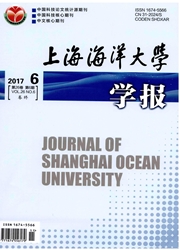

 中文摘要:
中文摘要:
为探讨三疣梭子蟹卵巢发育过程中孕激素受体(progestin receptor,PR)的调控作用,采用免疫印迹和免疫组化方法,首次对三疣梭子蟹卵巢、肝胰腺、大颚器、Y器官、视神经节和胸神经团中的PR进行免疫识别和定位,并系统研究了卵巢发育期间PR在这些器官中的分布和变化。结果表明:(1)三疣梭子蟹视神经节中存在PR阳性条带,分子量为100 ku;(2)PR仅在早期(Ⅰ~Ⅲ期)生殖细胞胞质和后期(Ⅲ~Ⅴ期)细胞核呈强阳性,但在各期滤泡细胞中始终呈强阳性;(3)PR阳性主要存在于Ⅰ~Ⅴ期肝胰腺F细胞和Ⅲ期R细胞核中,其余肝胰腺细胞中均无PR阳性;(4)大颚器腺细胞中的PR阳性仅发现于Ⅳ期腺细胞胞质中,各期Y器官腺细胞中均呈PR阴性;(5)就视神经节而言,PR主要存在于Ⅲ~Ⅴ期的神经细胞。就胸神经团而言,Ⅰ~Ⅴ期神经细胞中的PR阳性呈增强趋势,而Ⅰ~Ⅴ期神经髓质中PR始终呈PR强阳性。结果表明,孕酮不仅可以通过与卵巢和肝胰腺中PR结合直接调控三疣梭子蟹的卵黄发生和卵巢发育,还可能通过影响其它内分泌激素的合成和分泌来间接调控其卵巢发育。
 英文摘要:
英文摘要:
Progesterone is one of very important sex steroid hormones, which plays an important role during the ovarian development of crustaceans. In vertebrate, progesterone regulates the reproduction generally via progestin receptor(PR). Previous studies have shown PR is present in the ovary, hepatopancreas and nervous tissues for some crustacean species. The swimming crab, Portunus trituberculatus, is a commercially important fisheries resource and mariculture species in East Asian countries. The better understanding of reproductive mechanism would potentially benefit artificial propagation as well as fisheries management of P. trituberculatus. The present study was conducted to immunorecognize and immunolocalize PR in the ovary,hepatopancreas, mandibular organ, Y-organ, optic ganglia and thoracic ganglion mass of female P. trituberculatus via Western-blotting and immunohistochemistry. Then,the change and distribution of PR was also investigated in these tissues during the ovarian development of female P. trituberculatus. The results showed that PR with an apparent molecular weight of 100 ku was identified in the optic ganglia of female P. trituberculatus. By means of immunohistochemistry, PR was detected in the ovary, hepatopancreas, mandibular organ,optic ganglia and thoracic ganglion mass. During the ovarian development of female P. trituberculatus,the follicule cells were stained with strongly positive PR at each ovarian stage. As for the germinal cells,the strongly positive PR only exsited in the cytoplasm from the early ovary developmental stages,including stages Ⅰ , Ⅱ and Ⅲ ,while the strongly positive PR was stained in the nucleus of germinal cells during the stage Ⅲ to stage Ⅴ. For the female hepatopancreas, PR was mainly localized in the cytoplasm and nucleus of the fibrillar cell at all ovarian developmental stages, and PR was also present in the nucleus of stage Ⅲ resorptive cell. On the contrary, no positive PR-like substance was found in the other types of hepatopancreas cells, such as blis
 同期刊论文项目
同期刊论文项目
 同项目期刊论文
同项目期刊论文
 期刊信息
期刊信息
